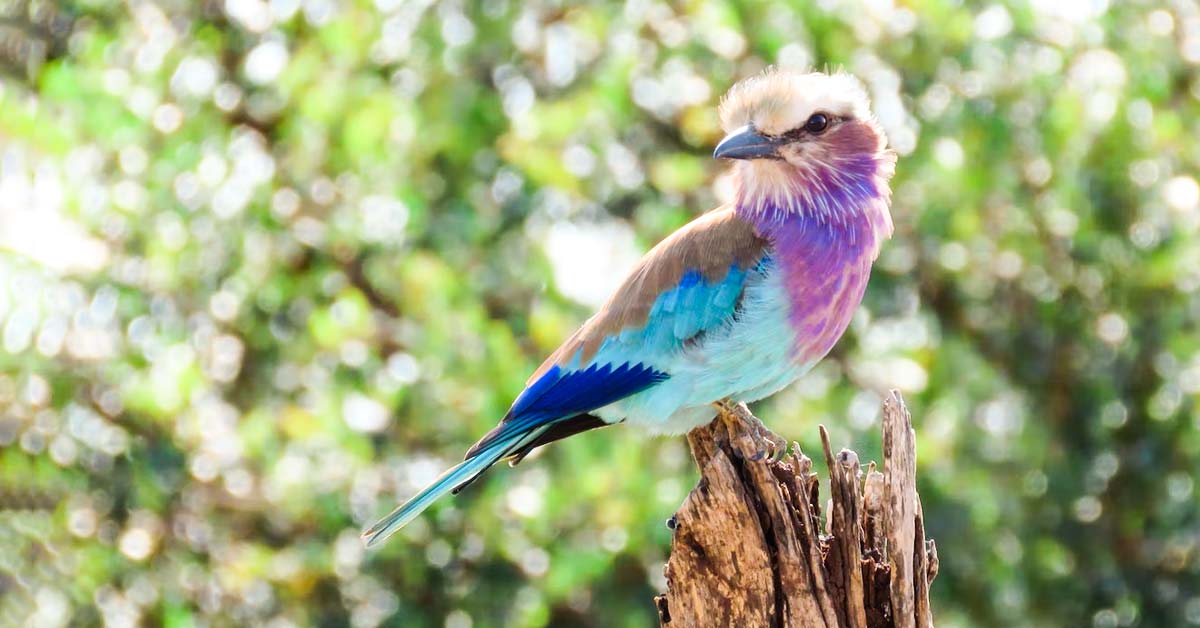Purple birds are some of the most striking birds around.
While a 100% purple-feathered bird is very rare, hundreds of birds exist with lilac, violet, plum, and purple hues.
If you’re interested in spotting one (or all), check out these 10 stunning purple birds from around the world and discover if you’re able to visit them up close.
10 Beautiful Purple Birds around the World
Purple birds look dramatically regal. See for yourself:
1. Violet Sabrewing (Campylopterus hemileucurus)
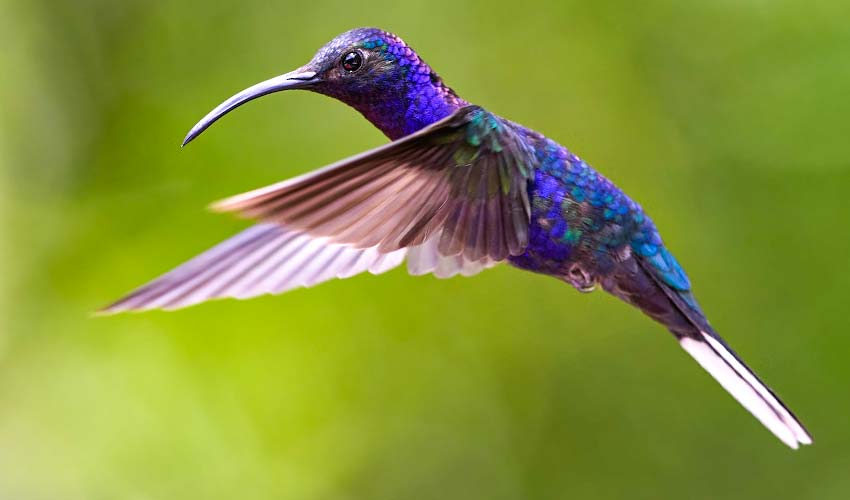
- Where does the Violet Sabrewing live? Panama, Mexico, Costa Rica, and other South American regions
- Habitat: Forest
- Male vs. Female: Male Violet Sabrewing has purple feathers in all areas except its back (the back is often green). Females, on the other hand, have purple spots on the throat with gray and dark green feathers.
- Conservation Status: Common (not endangered)
This larger-than-most hummingbird actually has blackish plumage, which totally showcases its flashy purple plumage when it catches the light.
Violet Sabrewings feed on flowering plants and love drinking nectar, spiderwebs, and other arthropods.
As a songbird, the song of Violet Sabrewing is described as a high-pitched “cheep tsew cheep tik-tik tsew cheep.”
2. Gouldian finch (Chloebia gouldiae)
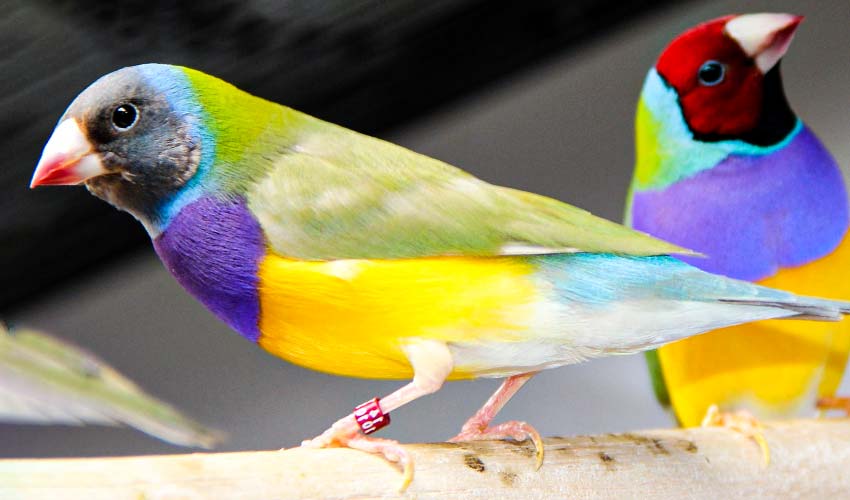
- Where does the Gouldian Finch live? Australia
- Habitat: Tropical savanna woodland
- Male vs. Female: Adult male Gouldian Finches have bright purple breast feathers, while adult females have a duller purple chest.
- Conservation Status: Near threatened
Also known as Lady Gouldian Finch or “Rainbow Finch,” this Australia-native passerine bird isn’t an all-purple bird, but its vivid colors (yellow belly, green back, and blue nape) are pretty striking.
Plus, its purple chest is bold enough to be included on this list.
One of the most interesting things about Gouldian finches is that the females have been shown to control the sex of their offspring by choosing their mates based on their head color.
Also, Gouldian finches are seed eaters. Every day, they fill up 30% of their body with food.
3. Broad-billed Hummingbird (Cynanthus latirostris)

- Where do Broad-billed Hummingbirds live? Mexico and the southwestern United States
- Habitat: Oak and cotton woodlands
- Male vs. Female: Adult male Broad-billed Hummingbirds have rich green plumage and blue throat with a black-tipped red bill. Female counterparts have a white line behind the eye, gray underwings, and a tinge of gold. Both males and females have ombre purple plumage all over.
- Conservation Status: Least Concern (population is increasing)
This small-sized hummingbird love feeding on tiny insects and nectar from flowers like desert honeysuckle. Broad-billed Hummingbirds can devour 1.7 times of their weight in nectar each day, using their bill.
The song of male Broad-billed Hummingbirds is actually softer than other hummingbird families.
Love hummingbirds? Check out the melodious song birds of Pennsylvania.
4. Boat-tailed Grackle (Quiscalus major)
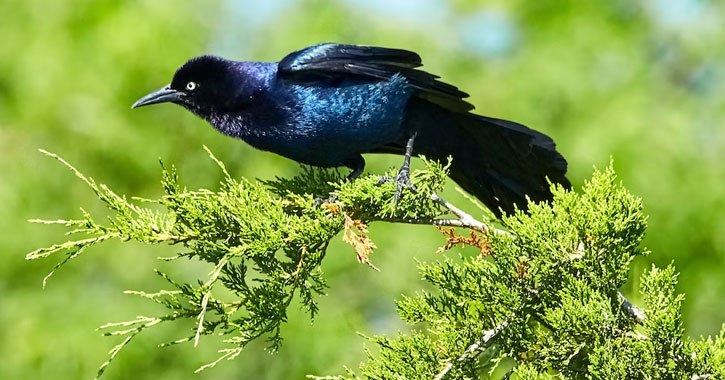
- Where does Boat-tailed Grackle live? Coasts of the Southeastern United States
- Habitat: Grasses of freshwater, saltmarshes or brackish marshes
- Male vs. Female: Male Boat-tailed Grackles have glossy black feathers all over with an iridescent purple sheet, while females are brown on the upper plumage and darker brown with black below.
- Conservation Status: Common (about 2 million population as of 2015)
Boat-tailed Grackles are large birds with long tails (that make up half of their body length). They are often seen in coastal areas, where they hunt for food and nest.
These Boat-tailed Grackles feed on everything from seeds, nectars, flowers, amphibians, crustaceans, reptiles, and even food scraps they find by the shore.
5. Little Blue Heron (Egretta caerulea)
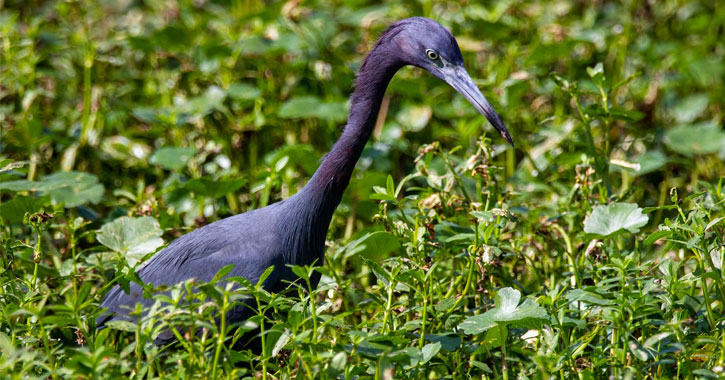
- Where do Little Blue Herons live? Missouri, Virginia, Florida, and Texas
- Habitat: Fresh, salt, and brackish water like swamps, estuaries, ponds, lakes, and rivers
- Male vs. Female: Male and female Little Blue Herons have the same coloration: plum-like dark blue bodies with purplish maroon heads.
- Conservation Status: Least Concern (but the population is decreasing)
Little Blue Herons are medium-sized, long-legged wading birds that feed on fish, crustaceans, amphibians, insects, and reptiles.
These intimidating birds hunt on shallow water and wait for their prey to pass by, using their pointy bill to grab them.
6. Lilac-breasted Roller (Coracias caudatus)
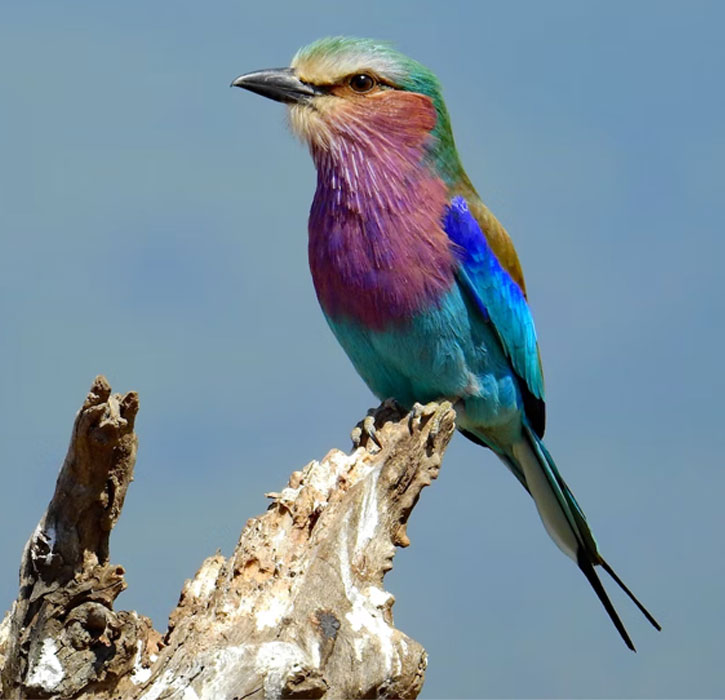
- Where do Lilac-breasted Rollers live? Sub-Saharan Africa and the southern Arabian Peninsula
- Habitat: open woodland and savanna
- Male vs. Female: Male and female Lilac-breasted Rollers have similar appearances. They have 8 colors, green, white, yellow, turquiose, reddish brown, dark blue, and lilac (as their name suggest) patch of feathers on their chest.
- Conservation Status: Stable (least concern population)
Lilac-breasted Rollers are the stunning national bird for both Kenya and Botswana.
The name “roller” comes from the acrobatic movements of males during their courtship dance.
Lilac-breasted Rollers feed grasshoppers, crabs, insects, amphibians, fruit salads, mealworms, and sometimes, very-small birds.
7. Japanese Paradise Flycatcher (Terpsiphone atrocaudata)
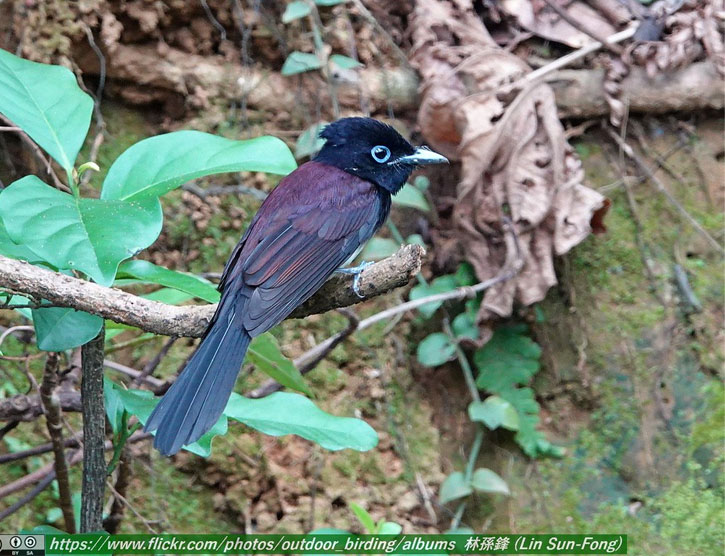
- Where do Japanese Paradise Flycatchers live? Japan, South Korea, Taiwan, Philippines, Malaysia, Singapore, Vietnam, Indonesia, Thailand, China, and other Asian countries.
- Habitat: Forests and wooded areas
- Male vs. Female: The body of male Japanese Paradise Flycatchers is purplish brown with a dark head and light-colored underbelly, while females have reddish-brown plumage.
- Conservation Status: Near Threatened (Population decreasing)
Also called the “black paradise flycatcher,” this passerine bird feed on various insects.
The song of a Japanese Paradise Flycatcher sounds like a series of coarse whistles, while their calls are rough and nasal.
8. Violet-Backed Starling (Cinnyricinclus leucogaster)
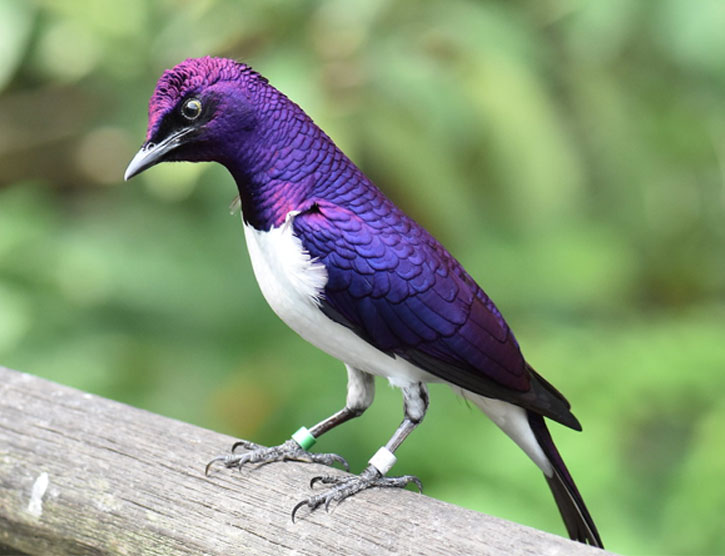
- Where do Violet-backed Starlings live? Southwest of the Arabian Peninsula to sub-Saharan Africa
- Habitat: open woodland, grassland and gallery forests
- Male vs. Female: Male violet-backed starlings have white breasts and iridescent violet back, while females have brown heads and backs.
- Conservation Status: Least Concern (Population decreasing)
Violet-backed Starlings are pretty small – they weigh just an ounce and measure only about six inches), but the coloration is exceptionally vibrant that you can spot these birds even from afar.
These gorgeous purple birds are monogamous – they stick to one partner until their mate dies (and only then will Violet-backed starlings find a replacement).
Violet-backed Starlings are omnivorous birds. They feed on fruits like figs or mulberries, and insects like bees, wasps, locusts, termites, and butterflies.
9. American Purple Gallinule (Porphyrio martinicus)
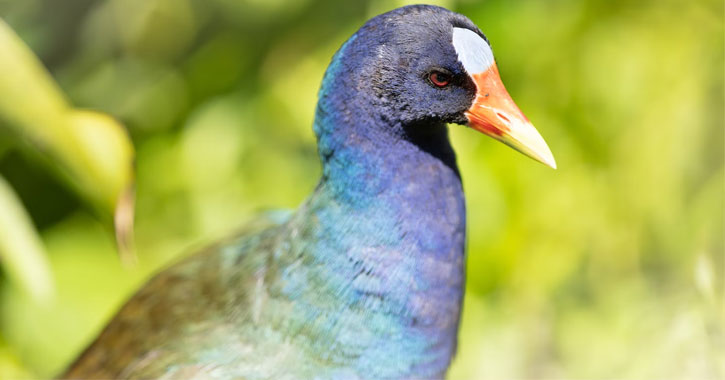
- Where do American Purple Gallinules live? South Carolina, Georgia, Florida, Arkansas, Louisiana, Mississippi, Alabama, Texas, and Oklahoma.
- Habitat: Freshwater marshes
- Male vs. Female: Male and female birds look the same in this species with pale blue forehead, red-and-yellow bill, and purple-bluish plumage that shine turquoise and shimmery green in good lighting. However, males are slightly larger.
- Conservation Status: Widespread with no evidence of significant population
Adult American Purple Gallinules are omnivores. They will eat plants, seeds, fruits, insects, spiders, frogs, snails, fish, earthworms, and other small animals.
Even if the American Purple Gallinules are known as bad flyers, these birds are excellent waders thanks to their big and long toes that distribute their weight even when walking on lily pads.
10. Mandarin Duck (Aix galericulata)
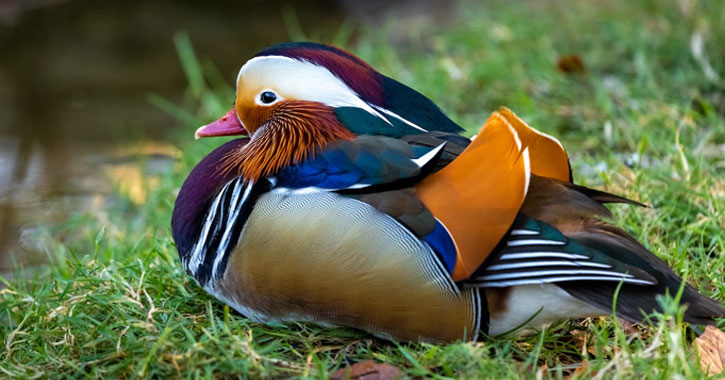
- Where do Mandarin Ducks live? China, Japan, Korea, Russia, and California
- Habitat: Forests, woodlands, rivers, streams
- Male vs. Female: Male Mandarin ducks are colorful with a mix of green, brown, orange, red, and purple plumage. Females have grayish-brown feathers with a pink-tinged bill and white eye ring.
- Conservation Status: Least Concern (but the population is decreasing)
Mandarin ducklings are almost identical in appearance to wood ducklings, and very similar to mallard ducklings.
Mandarin Ducks eat a variety of food depending on the seasons.
Normally, they eat plants, seeds, snails, small fish, and other small insects. In the fall/winter, these birds scourge on grains, acorns, and seeds. In the summer, these ducks prefer mollusks, small snakes, and dew worms.
Hundreds of Purple Birds
This list is just some of my favorite purplish birds. I’m sure there are hundreds more.
Did you know that many of these purple-tinged bird species feature iridescent feathers?
Yes, the purple color on most of them is only produced by structural coloration, which means the vividness/brightness of the purple color will depend largely on lighting.
In some cases, the purple feathers will only appear when the sun is shining on the birds, then look black, brown, or blue once the light disappears.
In addition, isn’t it interesting that many of the purple birds on this list are male species of a certain bird (with their female counterparts colored in a duller color like brown)?
